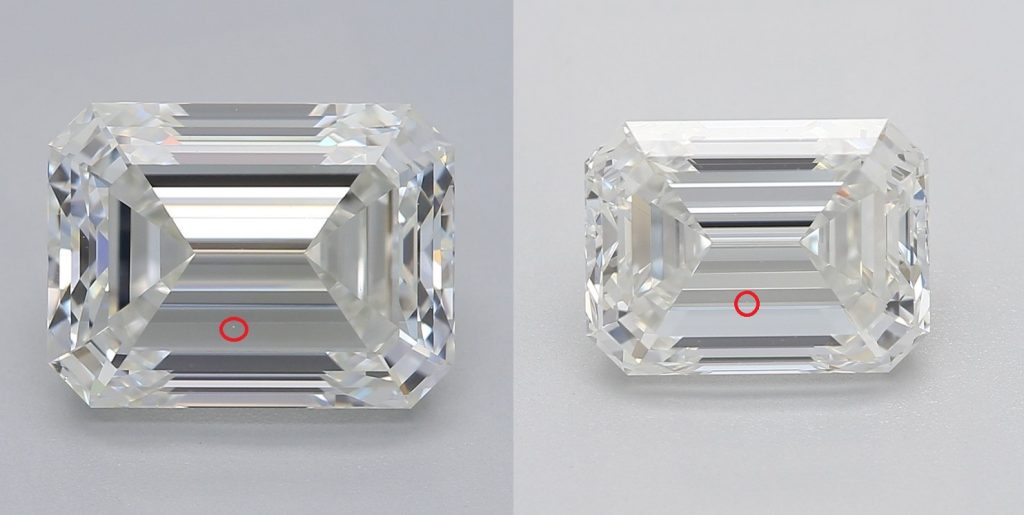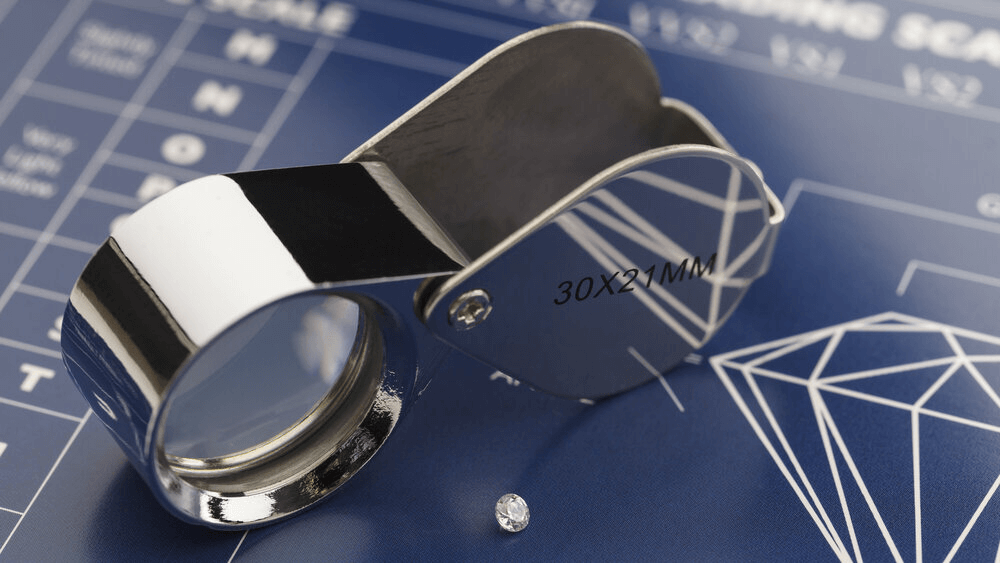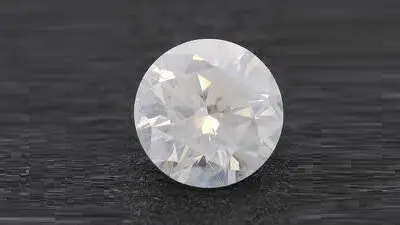VS Diamonds: The Next Level Of Clarity

By Gary A.

Edited by Olivia H.
Published Sep 24, 2021
Edited on Dec 17, 2024
When it comes to finding the perfect balance of beauty and value, VS diamonds offer a clarity that’s hard to beat, but are they the right choice for your engagement ring?

- 8 Quick Tips for Examining VS Diamond Clarity When Buying an Engagement Ring
- Introduction
- Overview of VS Diamond Clarity
- VS Diamond Rarity
- VS Diamond Quality and Appearance
- Investment Insights: VS Diamonds
- Our Expert Take
- 12 FAQs
Before we dive deeper into the specifics, here are some practical tips to help guide your decision-making process:
8 Quick Tips for Examining VS Diamond Clarity When Buying an Engagement Ring
- Tip 1: Understand the VS Grading Scale: Familiarize yourself with what ‘VS’ (Very Slightly Included) means. VS diamonds have minor inclusions that are difficult but not impossible to see under 10x magnification.
- Tip 2: VS1 vs VS2: Recognize the difference between VS1 and VS2 grades. VS1 inclusions are less noticeable than those in VS2 diamonds.
- Tip 3: Utilize Magnification Tools: Use a jeweler’s loupe or a microscope to examine the diamond. Look for tiny flaws or inclusions that might be present. Self-Examination: Practice examining diamonds under magnification to understand what inclusions in a VS diamond look like.
- Tip 4: Assess the Diamond in Different Lighting Conditions: View the diamond under various light sources — natural daylight, LED, and incandescent light. Different lighting can reveal or hide certain aspects of the diamond’s clarity. Inclusion Visibility: Pay attention to how visible any inclusions are in each type of lighting.
- Tip 5: Consider the Diamond’s Cut and Shape: Remember that the cut of the diamond can affect the visibility of inclusions. Brilliant cuts like round or princess tend to hide inclusions better than step cuts like emerald or Asscher. Shape Selection: Choose a shape that complements the clarity. Some shapes are more forgiving of inclusions than others.
- Tip 6: Evaluate the Placement and Type of Inclusions: Identify where the inclusions are located. Inclusions near the center or on top of the diamond are more visible than those near the edges or bottom. Type of Inclusions: Understand different types of inclusions (like feathers, clouds, or crystals) and how they impact the diamond’s appearance.
- Tip 7: Inspect for Eye-Cleanliness Eye-Clean Standard: Determine if the diamond is ‘eye-clean’ — meaning inclusions are not visible to the naked eye from a normal viewing distance. Personal Perception: Remember that eye-cleanliness can be subjective, so trust your own vision and comfort level with any visible inclusions.
- Tip 8: Compare with Other Clarity Grades: View VS diamonds alongside diamonds of other clarity grades (like SI or VVS) to understand the differences. Value Assessment: Weigh the cost differences against the visible differences in clarity to determine what provides the best value for your budget.
Now that you’ve got these practical tips, use Jeweler AI below to find the perfect engagement ring that suits your style and budget:
Introduction
When it comes to clarity, one of the main things new shoppers need to realize is the fact that there is plenty of leeway to find an eye clean diamond.
While, in order to get a beautiful and sparkling stone, you’ll need to stick to the very top two grades for cut (Excellent and Very Good), it is totally possible to find a visually flawless diamondfrom a grade way below FL and IF.
This is great news for plenty of reasons. For starters, it means you won’t have to spend years waiting for a flawless diamond to come along – and, given they represent less than 1% of all diamonds mined, you and your future bride would be waiting a while.
Furthermore, it means you have the ability to save thousands of dollars on the cost of your diamond – thousands of dollars that you can put towards finding a larger diamond still available in your price range.
It’s a no-brainer, really – provided you know where on the clarity scale you should focus your search.
Overview of VS Diamond Clarity
By now, you might already have a pretty broad overview about the clarity grades clear in your mind. Then again, you might be just getting started. Either way, here’s a refresher on the clarity grading scale – and a much closer look at the VS grade.
The Clarity Spectrum: Understanding VS
While there are a number of scales used for identifying a diamond’s clarity, but, as you might have realised by now, the GIA’s system is the most widely used, recognized, and accepted.
This scale is used only to review the presence (or absence) of inclusions and blemishes, and not a diamond’s color, fluorescence, or symmetry. It runs from FL and IF diamonds, which are considered to be free from any inclusions under magnification, through ‘Very Very Slightly’ and ‘Very Slightly’ included diamonds (VVS and, of course, VS), ‘Slightly Included’ (SI) diamonds, and, finally, Included (I) diamonds.
Aside from FL and IF, each diamond grade is separated into two degrees. For instance, VS1 and VS2. There are only minor differences between each degree, and these differences will rarely impact the appearance of the diamond when it is not under magnification.
In order to determine a diamond’s clarity grade, it is assessed under 10x magnification by two expert graders, who will note down every single inclusion they come across (however small or minor) and illustrate it on a diamond plot, which will be included within the GIA report.
As a casual shopper, every diamond you come across will feature inclusions – though it’s pretty unlikely you’ll be able to spot them, unless the diamond has a very low clarity grade.
As we alluded to above, there is no conclusively ‘ideal grade’ for engagement rings, and buying a good diamond doesn’t necessarily mean aiming for the highest grade you can possibly afford.
Decoding the ‘VS’ Grade
VS refers to diamonds that are ‘Very Slightly’ included – or, more specifically, diamonds featuring inclusions that are “minor and range from difficult to somewhat easy” to spot under 10x magnification.
This is the official description used by expert GIA diamond graders but, for you, it roughly translates to a wide variety of diamonds that, while they do feature inclusions, are still of a high enough quality that the grader won’t spot them the instant the diamond is placed under the microscope.
Comparing VS with Other Clarity Grades
SI can be the better choice for a lot of people. It depends on the size and shape of the diamond you are looking at, although there are plenty of excellent and well-priced options at both grades.
The GIA’s definition for SI diamonds is:
- “Inclusions are noticeable to a skilled grader under 10x magnification”
As you might expect, this means that plenty of SI diamonds (and, in particular, SI1 diamonds) are also eye clean, making the VS2 vs SI1 debate a little more complicated than you might have imagined – and one definitely worth doing your research on before you buy.
VS Diamond Rarity
Less than a fifth of all diamonds on the market today are thought to be VS, making them a relatively rare find.
While nowhere near as rare as FL or IF diamonds – or, for that matter, VVS diamonds – VS diamonds are still rarer finds than some of the lower clarity grades.
This is because of the fact that inclusions are incredibly common in diamonds, and that, since size is so highly valued among those looking to create beautiful diamond jewelry, plenty of stones are cut and sold with a relatively large number of inclusions.
So, not only are the overwhelming majority of diamonds mined from the earth full of inclusions (some minor, some more noticeable), but plenty of diamonds are cut in a way that means inclusions are left within them. VS diamonds are, of course, no different – for the cutter to create a flawless stone, they would have to remove significant portions of the rough stone, and this simply isn’t worth it.
VS Diamond Quality and Appearance
Almost all VS grade diamonds will appear eye clean.
The subject of eye clean diamonds is something you will want to get very familiar with before you start seriously shopping around for your diamond. For now, keep in mind that an eye clean diamond is worth far more to you than a diamond with an extremely high clarity grade, such as VVS1.
Normal Inclusions in VS Diamonds
VS diamonds can have a combination of inclusions, such as pinpoints, feathers, graining, twinning wisps, and crystals.
In fact, most diamonds contain most of the common types of inclusion. Diamond feathers, for instance, are highly common, and not considered an issue unless they’re much more substantial than they would be in a VS graded diamond.
In general, it really doesn’t matter what types of inclusion your diamond features (although it can be interesting to see them mapped out on your diamond’s plot) provided they’re small enough to preserve the visual and structural integrity of the diamond.

In this case, VS is a safe bet.
Light Performance
Any imperfections in a VS grade diamond (whether VS1 or VS2) will not be significant enough to have any discernible impact on brilliance or fire.
Diamonds need to be pretty heavily included for sparkle to be affected, and, for the most part, you really don’t need to worry about the relationship between your diamond’s clarity grade, and its light performance.
The reason we always recommend shoppers stick to the very highest grades possible when it comes to cut, however, is because this is the factor most relevant to sparkle. A diamond could have a pretty poor color and clarity and still sparkle beautifully – although you definitely wouldn’t want to invest in it.
Understanding the ideal proportions for your diamond’s cut is essential, and far more important than stretching your budget to reach a VVS grade on the off-chance that it will yield a better light performance.
In short, VS diamonds will sparkle – provided you don’t forget the importance of Cut quality.

Investment Insights: VS Diamonds
The main reason any diamond shopper will be drawn to these lower clarity grades is, of course, an interest in getting the best (and, likely, biggest) diamond they can out of their price range. If not, we’d all simply aim for the most flawless diamonds possible – even though they don’t look any better without strong magnification.
So how much can you really save if you shop from the VS category?
Market Trends and Demand
Like any diamond, VS graded diamonds vary significantly in price – from a couple thousand dollars to more than $10,000 – depending on many factors. In general, however, it’s good to keep in mind that VS diamonds are typically between 10% and 20% less than otherwise similar VVS diamonds.
In other words, let’s say you’re looking at a 1.5 carat diamond with Excellent cut, a clarity grade of VVS1, a color grade of H. You could feasibly shave as much as 20% off the price if you found a diamond that was pretty much identical in all respects except clarity – and, provided that second diamond was eye clean, you wouldn’t have to sacrifice any of the original diamond’s beauty for the sake of hundreds or thousands of dollars saved.
Alternatively, if you’re still ‘just browsing’, you could aim your sights a little higher and start looking at slightly larger diamonds. If your budget can’t take you to a 1 carat VVS diamond, then switching to the VS category could make it way easier for you to get there, without saving thousands of additional dollars before you can buy.
Value for Money
Would you rather have a small diamond – say, half a carat – to place in the center of your diamond ring and a GIA report that confirms it as being only very, very slightly included, or would you rather have a diamond approximately twice the size with a GIA report that confirms it features very slight inclusions?
For the exact same reason that the Near Colorless range of diamonds (grades G, H, I, and J) represent far wiser investments than the rare and super-expensive Colorless range (D, E, and F), a lower clarity grade is absolutely worth your while.
From the opposite viewpoint, VS diamonds can often be preferable to the savings available from SI diamonds.
There are plenty of beautiful, eye clean diamonds available at the SI grade, but if you’re looking for a large diamond, or a shape that is not so good at hiding flaws (like the Emerald or Asscher cut) then the VS clarity grades offer more scope for finding the right, eye clean diamond.
Our Expert Take
Absolutely. VS1 and VS2 represent two of the best grades for eye clean choices, particularly if you’re interested in looking at larger carat weights – although you won’t want to turn your back on the SI1 grade entirely just yet.
Out of all the clarity grades, the VS grades offer some of the best value. While the SI grades – and, in particular, SI1 – offer plenty of choice, they’re a little more restrictive at times, particularly when it comes to some of the fussier shapes, or larger diamonds.
For this reason alone, VS diamonds enjoy an incredibly strong position on the clarity scale. But, couple that with the fact that they offer the same impeccable, flawless appearance that could cost thousands of dollars extra if you were to shop from higher grades, and you can see quite how much better your experience will be if you narrow your search to these categories.
If you want to make sure you’re making the very best investment possible, we’d recommend widening your initial search to include the SI grades, too. If it turns out the type of diamond you’re looking for would be better off at a VS, then you’ll know you’re getting the best deal on your diamond, and that you’re not investing hundreds – or even thousands – of dollars into a clarity grade you don’t need.
12 FAQs
- What Does ‘VS’ Stand for in Diamond Grading?
- ‘VS’ stands for ‘Very Slightly Included,’ indicating minor inclusions in the diamond.
- Are VS Diamonds Eye-Clean?
- Yes, most VS diamonds are eye-clean, meaning their inclusions are not visible to the naked eye.
- How Does VS Clarity Compare to Other Clarity Grades?
- VS diamonds have fewer and smaller inclusions than SI (Slightly Included) diamonds but more than VVS (Very Very Slightly Included) diamonds.
- Is VS Diamond Quality Good for Engagement Rings?
- Absolutely, VS diamonds offer a great balance of quality and value, making them ideal for engagement rings.
- Can You Tell the Difference Between VS1 and VS2 Clarity?
- The difference is minor and often not noticeable without magnification. VS1 has fewer inclusions than VS2.
- How Important is Clarity in Choosing a Diamond?
- Clarity is important, but it should be balanced with other factors like cut, color, and carat weight.
- Does a Higher Clarity Grade Mean a Better Diamond?
- Not necessarily. A higher clarity grade means fewer inclusions, but factors like cut and color also significantly impact a diamond’s appearance.
- Should I Choose a VS Diamond Over a Higher Clarity Grade?
- It depends on your preference and budget. VS diamonds offer excellent value without compromising much on appearance.
- Are VS Diamonds a Good Investment?
- Diamonds, in general, are not the best investment vehicles. However, VS diamonds retain their value well due to their quality.
- Can VS Diamonds Have Visible Inclusions?
- It’s very rare, but some VS diamonds might have inclusions visible under certain conditions or angles.
- How is VS Clarity Determined?
- Skilled graders evaluate diamonds under 10x magnification to determine the size, number, and location of inclusions for VS grading.
- What Impact Does Clarity Have on a Diamond’s Price?
- Higher clarity usually means a higher price. However, the price is also influenced by other factors like carat weight, cut, and color.
Unlock the brilliance of VS diamonds with Jeweler AI – your gateway to the perfect engagement ring.
FOLLOW-UP GUIDE SERIES





















